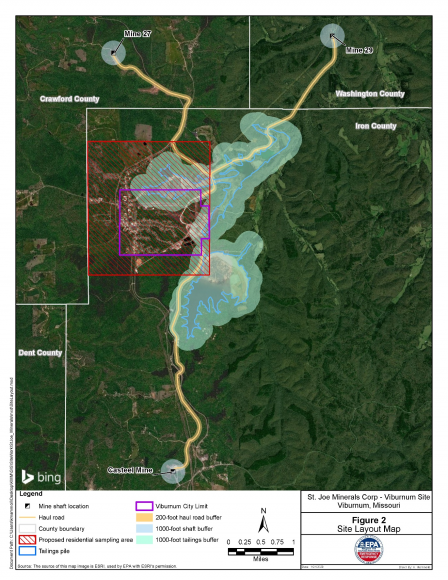Viburnum Trend Lead Haul Roads – City of Viburnum Operable Unit 2 Superfund Site; Crawford, Iron and Washington Counties, Missouri - Fact Sheet, October 2020
Removal Action Update
Lead Testing and Cleanup Overview
OVERVIEW
The U.S. Environmental Protection Agency (EPA) Region 7 is testing (sampling) for lead contamination in residential properties and child high-use areas within the Viburnum Trend Lead Haul Roads – City of Viburnum Operable Unit 2 (OU2) Superfund Site (site). EPA’s field support contractor will work with individual property owners in Viburnum to request access to conduct lead testing.
The site includes the city of Viburnum and additional nearby areas. Lead is the main contaminant of concern at this site, which was likely distributed throughout the city during decades of mining, milling and transporting of lead ores and concentrates.
SITE UPDATE AND OVERVIEW
EPA identified Doe Run Resources Corporation, or Doe Run, as the Potentially Responsible Party (PRP) for the lead contamination found at this site. Beginning in 2005, EPA and Doe Run entered into an agreement for Doe Run to begin cleaning up lead-contaminated residential properties in Viburnum. A time-critical removal action has been completed for residential properties and child high-use areas where lead concentrations in soils exceeded 1,200 parts per million (ppm).
- EPA is continuing to negotiate with the PRP about plans to clean up the remaining residential properties and child high-use areas with lead concentrations of less than 1,200 ppm in soil (that were without sensitive residents).
- In spring 2020, EPA held a 30-day public comment period for the Engineering Evaluation/Cost Analysis prepared for the site. This document further analyzed the environmental conditions and ways to clean up the contamination.
- Sampling of residential yards will continue until EPA’s investigation is complete.
- EPA will update the local community when additional information becomes available.
HOW WILL EPA SAMPLE MY RESIDENTIAL YARD?
EPA requests permission to sample residential properties from owners. By signing and returning the Soil Sampling Access Form (under Documents), the owner initiates the process. Once sampling results are received, EPA shares them with the owner and, if needed, discusses any potential cleanup. This work is currently being conducted at no cost to residential property owners. If your residential property qualifies for cleanup, an EPA representative will contact you to discuss the sample results and proposed cleanup activities for your property.
ABOUT LEAD AND PUBLIC HEALTH
Lead is a toxic metal that is harmful if inhaled or swallowed. Lead is classified by EPA as a probable human carcinogen and is a cumulative toxicant that affects multiple body systems and is particularly harmful to young children. Lead exposure can pose serious health risks, particularly for children 7 years old and younger; as well as pregnant women and nursing mothers, who should also avoid exposure to protect their children. Lead exposure can cause a range of adverse health effects, including behavioral disorders, learning disabilities and seizures, putting young children at the greatest risk because their brains and nervous systems are still developing. For more information about lead, see below and visit CDC’s Lead page and ATSDR ToxFAQs™.
ANNUAL BLOOD LEAD TESTING
The only way to know if your child has elevated blood lead levels is to have his or her blood tested. Talk to your pediatrician, general physician, or local health department about the testing your child.
For more information on blood testing for children, you can contact: Iron County Health Department, 606 W Russell St., Ironton, MO 63650; phone: 573-546-7121.
 VIBURNUM SITE MAP (click to enlarge)SITE BACKGROUND
VIBURNUM SITE MAP (click to enlarge)SITE BACKGROUND
The Viburnum OU2 Site is located in northwestern Iron County, with smaller portions within Crawford and Washington counties in southeastern Missouri. It is part of what is commonly known as the New Lead Belt mining district, or Viburnum Trend, where lead production began around 1960.
The Doe Run Resources Corporation – Viburnum Division (formerly St. Joe Minerals Corp. – Viburnum) is located in and near the city of Viburnum. The Viburnum Division includes four mines where ore was brought to the surface. (See site map at right.) During construction, development, and early operation of these mines, it was not uncommon for lead-contaminated materials, such as tailings and/or poor rock, to be used for construction materials in the building of Viburnum, which was done by the St. Joe Minerals Corp. to support mining operations. As a result of mining-related activities that have occurred in and around the city, lead and lead compounds have been released into the environment in quantities sufficient to present an imminent and substantial danger to public health and welfare.
EPA CONTACT INFORMATION
If you have questions about this Fact Sheet, need additional information about the site, and/or would like to receive site updates, please contact EPA:
Lenexa, KS 66219
FOR ADDITIONAL SITE INFORMATION
FOR ADDITIONAL LEAD INFORMATION
LEAD HEALTH EFFECTS
-
Slowed physical growth
- Hearing problems
- Nervous system and kidney damage
- Learning difficulties
- Behavioral problems, including hyperactivity (easily excitable or upset, unable to concentrate, short attention span); decreased intelligence (I.Q.) scores
-
Wash hands after playing outside and before meals. Regularly wash children’s hands, bottles, pacifiers, stuffed animals, and toys.
- Keep play areas clean.
- Regularly clean floors, windowsills, and other surfaces. Vacuum often and dust with a damp cloth to help remove dust that might have lead in it. Use a mop or sponge with warm water and general all-purpose cleaner. Thoroughly rinse sponges and mop heads often during cleaning of dirty or dusty areas, and again afterward.
- Remove shoes/boots or wiping soil from shoes before entering your home to avoid tracking in lead from soil.
- Make sure children avoid fatty (or high fat) foods and eat nutritious meals high in iron and calcium. Children with good diets absorb less lead.
